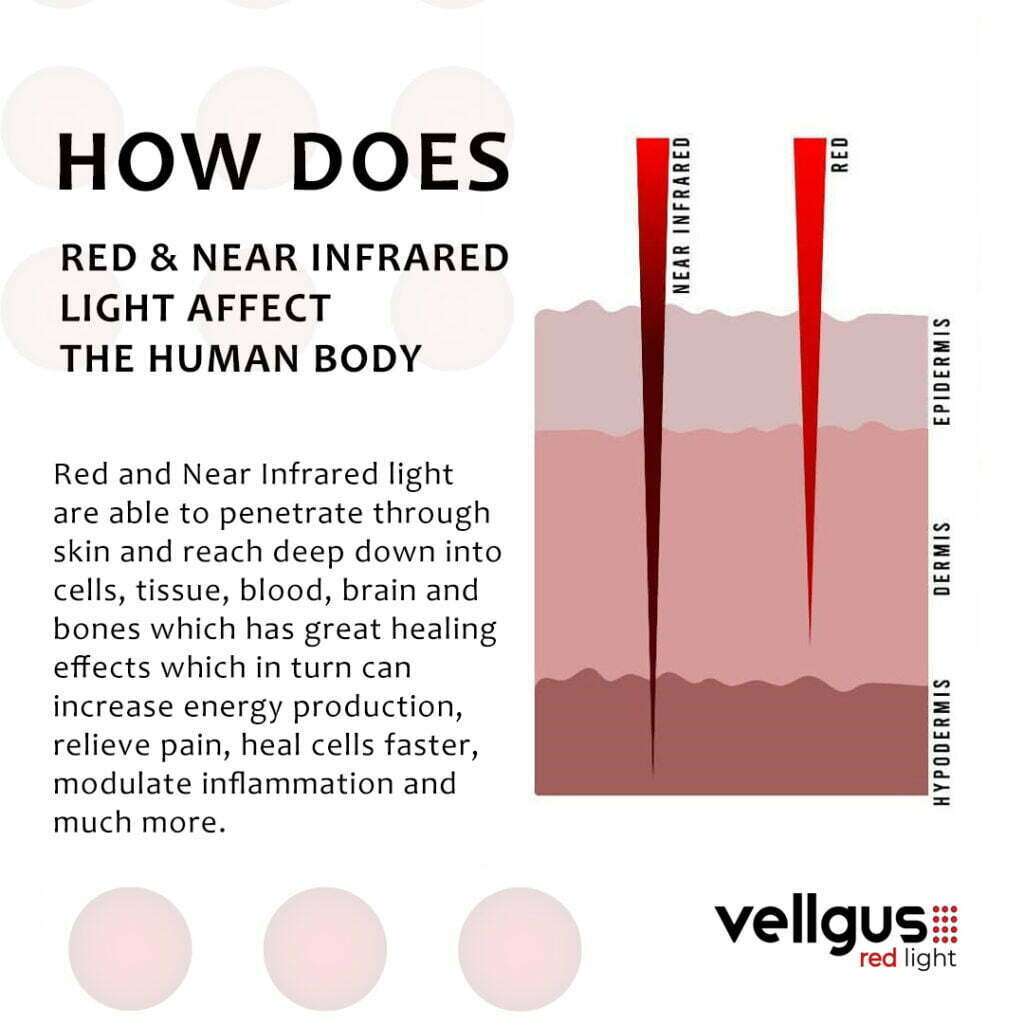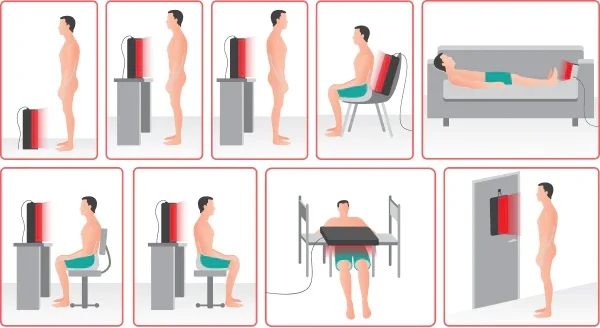Red Light Therapy for Reducing Pain and Inflammation: Tips and How to Use It
Red Light Therapy (RLT) is a powerful and non-invasive treatment option for reducing pain, inflammation, and other symptoms associated with chronic illnesses. RLT has been used as an alternative therapy for many conditions including arthritis, fibromyalgia, chronic fatigue syndrome, multiple sclerosis, depression, and migraines. This type of therapy works by emitting red light photons that penetrate deep into the body’s tissue and stimulate cellular repair and recovery. It is thought to reduce inflammation, promote healing, and improve circulation, among other potential benefits.
RLT is widely used in medical settings for its many therapeutic benefits. When used correctly, it can help reduce pain and inflammation caused by chronic conditions, as well as improving overall health and well-being. With this in mind, let’s take a closer look at how to use Red Light Therapy for reducing pain and inflammation.
[ruby_related heading=”More Read” total=3 layout=1 offset=5]
What is Red Light Therapy and How Can it Help Reduce Pain and Inflammation?
Red light therapy is an alternative medical treatment that uses low-level wavelengths of red light to stimulate natural healing processes in the body. It’s believed to work by activating chemicals called photoacceptors, which then promote the production of collagen and elastin — two proteins that help keep skin healthy, reduce inflammation, and improve blood flow. Red light therapy can also help reduce pain and inflammation by promoting the release of endorphins, which are natural hormones that block pain signals from reaching the brain. In addition to helping relieve pain, red light therapy has been used to treat a range of other conditions, such as acne, joint and muscle pain, depression, and wrinkles. It may even be useful for treating chronic skin conditions like psoriasis and eczema. While it’s still not entirely clear how red light therapy works, studies suggest that it can be an effective treatment for reducing pain and inflammation.

It is generally considered safe, with few side effects or risks. As always, it’s important to discuss red light therapy with a healthcare professional before trying it. However, for those who are looking for an alternative treatment that may help reduce pain and inflammation without the use of drugs or surgery, red light therapy may be worth considering. It has the potential to be an effective, non-invasive treatment option for those suffering from chronic pain and inflammation.
Types of Red Light Therapy
Photobiomodulation
Photobiomodulation is a form of red light therapy that works by using visible or near-infrared wavelengths to help reduce pain, inflammation and accelerate healing and tissue regeneration. It can be applied directly to the skin or used at a distance depending on the desired effect.
LED Therapy
LED Therapy works by using low-level light energy that penetrates deeply into the skin. This type of therapy helps stimulate collagen production and cell regeneration, which can improve overall skin health. It also has anti-aging effects since it helps reduce wrinkles and sun damage.

Low Level Laser Therapy
Low Level Laser Therapy (LLLT) is another form of red light therapy that is used to treat a variety of conditions including wounds, muscle pain and scar tissue. This type of therapy works by stimulating the body’s natural healing process and can help reduce inflammation and promote wound healing.
Near-Infrared Therapy
Near infrared therapy (NIR) uses light at wavelengths of 800–1400 nanometers to penetrate deeply into the skin. This type of therapy is used to treat chronic pain, muscle spasms, and inflammation. It can also be used to stimulate natural healing processes in the body and help improve overall skin health.
Intense Pulsed Light Therapy
Intense Pulsed Light (IPL) therapy is a form of light-based treatment that uses short pulses of intense light to treat a variety of skin conditions. It can be used to reduce wrinkles, sun damage and age spots as well as treat acne, rosacea, and other vascular lesions. IPL therapy is also used for hair removal and photorejuvenation.
Benefits of Red Light Therapy – Decreasing Pain and Inflammation While Improving Overall Health
Reducing Pain and Inflammation
Red light therapy has been scientifically proven to reduce pain and inflammation in a non-invasive, drug free way. This makes it an ideal treatment option for those suffering from chronic pain or injury related inflammation.
Improving Blood Circulation
Red light therapy helps improve the circulation of blood which can make it easier for essential nutrients and oxygen to reach injured areas of the body. This can speed up the healing process, as well as helping reduce swelling and inflammation.
Boosting Immune System
Red light therapy has been shown to help improve immune system function, which helps with overall health and well-being. Increased immunity can also help fight off illnesses and minor infections.
Increasing Cellular Energy
Red light therapy helps to stimulate the production of ATP (adenosine triphosphate), which is the main energy source for cells in the body. Increased cellular energy can help improve muscle performance and endurance, as well as increasing skin cell renewal and regeneration.
Promoting Relaxation
Red light therapy can help promote relaxation as it helps reduce stress and tension in the body. It also helps to improve sleep quality, which can improve overall mood, energy levels, and mental clarity.
Enhancing Skin Health
Red light therapy is commonly used to treat skin conditions such as acne, wrinkles, age spots, and sun damage. This treatment stimulates collagen production, which can help to reduce the appearance of wrinkles and improve overall skin tone. It can also boost circulation in the skin to give it a natural glow.
Stimulating Hair Growth
Red light therapy has been shown to stimulate hair growth by stimulating the follicles and inducing them into the anagen (growth) phase of the hair cycle. This can help promote thicker, fuller hair with improved texture and shine.
Enhancing Athletic Performance
Red light therapy can improve muscle performance and endurance due to improved cellular energy. This can help athletes enhance their performance and recovery times, allowing them to train and compete at higher levels.
Improving Nervous System
Red light therapy helps improve communication between the nervous system and cells in the body, which can help with pain relief as well as improving overall health. The increased circulation of blood also delivers essential nutrients to the brain, helping to improve mental clarity and focus.
How to Use Red Light Therapy at Home
Set Up a Red Light Therapy Device
Before beginning a session, it’s important to set up the device properly. This involves carefully following instructions and setting up the device in an area with plenty of ventilation. It is also essential to select the appropriate settings for your needs and ensure that you are comfortable during your session.
Position Yourself Properly
Once the device is set up, it’s time to position yourself in front of the device. Make sure that you are at least 18 inches away from the light source and that you don’t look directly into the light. Additionally, consider wearing protective eyewear if you are using a high-intensity device.
Time Your Session
When it comes to red light therapy, time is of the essence. The amount of time you spend in front of the device will depend on your needs and the settings that you have chosen. Generally speaking, it’s recommended to spend between 5 to 30 minutes per session in order to receive optimal benefits. With a consistent routine and proper care, best red light therapy devices can provide amazing results for people looking to improve their skin and overall well-being.

Take Care of Your Skin After a Session
After each session, be sure to take good care of your skin by applying a moisturizer or other topical products. Additionally, it’s important to protect you skin from the sun with sunscreen and hats as exposure to UV rays can reverse many of the benefits of red light therapy.
Incorporate Red Light Therapy into Your Routine
To maximize the effects of red light therapy, make sure to incorporate it into your regular routine. As little as 10 minutes per day can make a huge difference in the way you look and feel. With consistent use, you can start to reap the rewards and enjoy glowing, healthy skin.
What Scientific Studies Say About the Effectiveness of Red Light Therapy
Scientific studies have demonstrated the effectiveness of red light therapy in treating a range of medical conditions. A study published in 2018 in Photomedicine and Laser Surgery showed that red light therapy was effective for reducing pain, improving wound healing, and decreasing inflammation associated with musculoskeletal disorders.
2018 study in Lasers in Surgery and Medicine found that red light therapy was effective for treating symptoms of acne, psoriasis, and other skin conditions. A study published in 2017 in Neuroscience Letters found that red light therapy improved cognitive performance and memory recall.
A 2019 review conducted by researchers at the University of Barcelona found that red light therapy is effective in treating hair loss, depression, and acne. The review also noted that more research is needed to understand the effects of red light therapy on other medical conditions such as dermatitis, Parkinson’s disease, and Alzheimer’s disease.
A 2020 study conducted by researchers from the University of London concluded that red light therapy is a safe, non-invasive, and effective treatment for chronic wounds. The study found that red light therapy significantly improved wound healing time and reduced the severity of pain associated with the wound.
A 2021 study from the University of Tokyo found that red light therapy was effective in reducing fatigue and increasing cognitive function in healthy adults. The researchers concluded that red light therapy could be an effective intervention for improving mental health.
2023 research from Harvard Medical School concluded that red light therapy is a safe and effective treatment for reducing wrinkles and improving skin texture. The study found that red light therapy significantly improved the signs of aging without causing any adverse side effects.
Making Red Light Therapy Part of Your Lifestyle – How to Incorporate It into Your Daily Routine
If you’re considering adding red light therapy into your routine, it’s important to find a way that works for you. Red light therapy can easily become part of your daily life if you commit to making it happen. Here are some tips on how to incorporate this powerful tool into your lifestyle:
1. Set aside time each day – Make sure to set aside at least 10 minutes each day for red light therapy. This will allow your body enough time to absorb the benefits of the light and help you establish a consistent routine.
2. Have a dedicated space – If possible, create an area in your home or office dedicated to red light therapy. This could be as simple as a few items on your desk or a corner of the room with a chair and light. Having a dedicated space will help you to stay focused and consistent with your red light therapy routine.
3. Stick to a pattern – Decide on what time works best for your schedule, then stick to that same time every day. This will make it easier for you to stick with your routine and prevent any missed appointments.
4. Make it enjoyable – Experiment with different music, scents or activities to make your red light therapy experience more enjoyable. This will help you stay committed and excited about your daily routine.
FAQ:
How often can you use red light therapy for pain?
The frequency of red light therapy use for pain relief depends on the individual and the severity of their condition. It is recommended that individuals with chronic conditions start with daily treatments for 1-2 weeks and then reduce to two or three times a week depending on results. For acute conditions, treatments may be administered up to 3 times a day for 1-2 days followed by a reduction in frequency as needed. Be sure to consult with your healthcare provider for specific guidance on red light therapy use for pain relief.
What do doctors say about red light therapy?
Many doctors and healthcare providers support the use of red light therapy. Studies have shown that red light therapy can be effective in treating pain, inflammation, wound healing, skin conditions and joint mobility. It is important to remember that results vary depending on individual circumstances and it is best to consult with your healthcare provider before using red light therapy for any condition.
Are there any side effects from red light therapy?
Generally, red light therapy is a safe and non-invasive treatment with few to no side effects. However, individuals who are pregnant or have a history of skin cancer should consult their doctors before using any type of light therapy. Additionally, those taking certain medications may experience increased sensitivity to the light, so be sure to check with your doctor first.
Is red light therapy covered by insurance?
Generally, insurance companies do not cover the cost of red light therapy treatments. However, as this type of treatment grows in popularity and more research is conducted on its efficacy, some providers may begin to offer coverage for certain conditions. It’s best to check with your insurance provider for specific coverage details.
Does red light therapy get rid of inflammation?
Red light therapy has been shown to reduce inflammation in some cases, but it is important to note that results vary depending on individual circumstances. It can be used in combination with other treatments for best results. Be sure to check with your doctor before starting any red light therapy regimen.
Is 10 mins of red light therapy enough?
The duration of red light therapy treatments will vary depending on the individual and their condition. Generally, treatments can last from 5-15 minutes but it is best to consult with your healthcare provider for specific guidance. Additionally, it may be necessary to increase or decrease the time as needed based on results.
What is the best red light therapy for inflammation?
The best type of red light therapy for inflammation will depend on the individual and their condition. Generally, treatments with a wavelength between 633-660 nm are most effective for reducing inflammation. Vellgus Elite Lamp is a great option for red light therapy and provides adjustable settings to accommodate different wavelengths.





